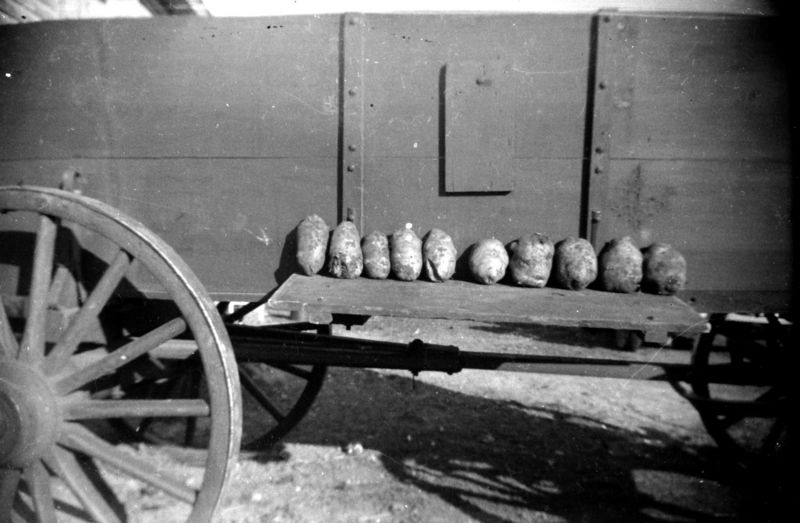 |

| |
|
|  |
Miller High Life: King of Wisconsin
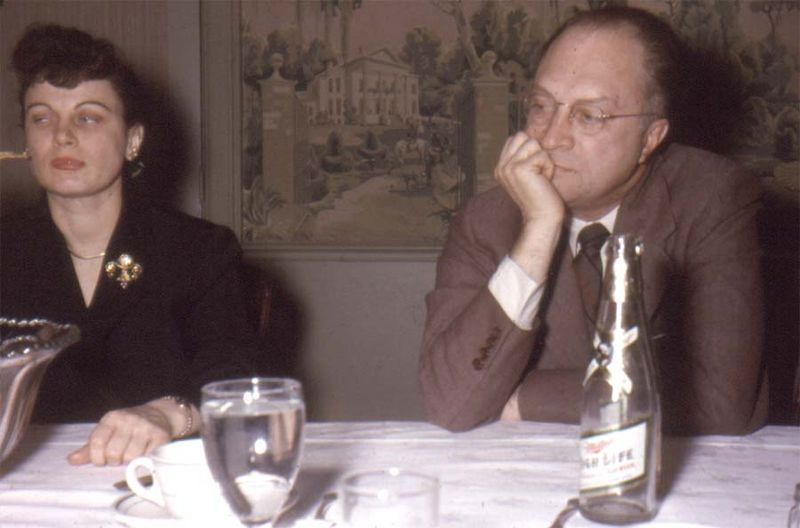 You may think Wednesday's crack about Grandma getting tipsy off a couple ounces of Miller High-Life was a joke, the photo above shows that the Cool Kids drank High Life. This is clear proof is from the Pfister Hotel set, but the distinctive trapezoid label with an 'X' sticker right above it makes the bottle very recognizable even in small photos from other sources. Granted, these photos are from Wisconsin -- Milwaukee is the home of Miller Brewing, and until the 70s there wasn't as much national distribution as there is today. People tended to drink the beer that was brewed nearby, partly out of sentimental reasons, but also because you knew the beer was fresh. Your parents probably have stories about driving to another state to buy some good beer -- driving from North Dakota to Colorado to buy up a pickup-truckload of Coors has been told to be by more than one person. One poster at Beer Advocate tells of driving to Wisconsin for some High Life...but more because of the lower drinking age of 18. As for the sentimental reasons, High Life had already been around for fifty years by the time this photo was taken -- it was "the champagne of beers", for crying out loud. Regardless if the stuff tasted like crap, you didn't dare buy something else when company was coming over, and being caught at a swanky hotel lounge drinking anything else would be a travesty. Labels: beer, miller high life, pfister hotel, wisconsin history
Getting Grandma Plastered
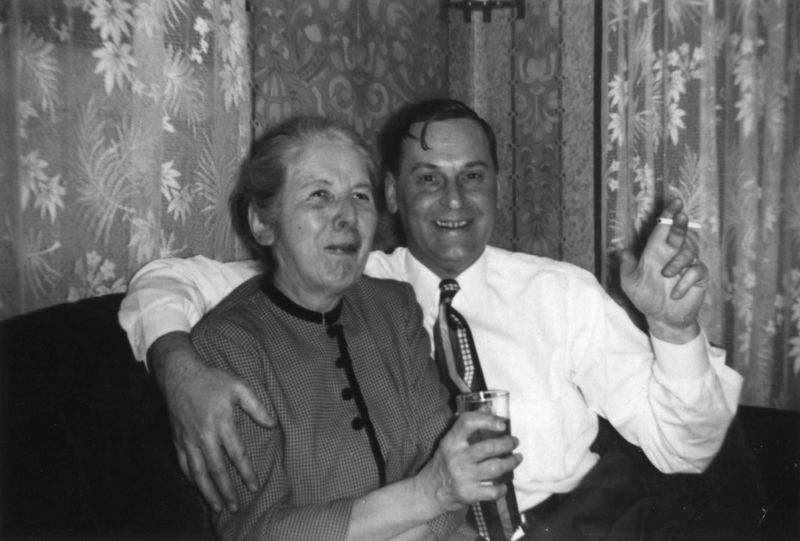 Give Grandma a jelly-jar glass of Miller High-Life, and she might start to get a bit tipsy, don't you know. Sometime in the 50s in Wisconsin, there was a party -- I've got more pictures to upload -- that prove there's a big gap in what partying means today. In the 21st century, partying is what kids do. People get wasted on their 21st birthday, get their first job and drink every Friday and Saturday in bars with loud, untalented rock bands screaming into microphones, and sleep the bender off every Sunday. By the time they're thirty, those childish ways are behind them and partying now means a $12 martini with a $20 steak and a jazz trio in the corner. The fifties were less age-centric in their parties: Kids did their partying when they had the money and time to do so, but grown-ups didn't see getting plastered as a childish activity. If you're in your thirties, ask your parents for stories about your grandparents: unless they were teetotalers, they probably had raucous parties...which, for the time period, meant listening to mildly naughty comedy records, playing cards, air so smoky it turned blue, drinking so much that someone had to be carried home, and driving all over town without fear of being stopped by the cops unless you actually hit something (then sitting bleary-eyed through church the next day). No wet t-shirt contests, no noise ordinance violations, no stepping over people sleeping on the floor at 11am who were too drunk to drive, no vomit on the front porch -- fifty years makes all the difference. Especially the wallpaper and drapes. The modernism of the sixties and seventies have ruined our decor. In the fifties, you could install flocked wallpaper without any sort of irony. Today, we might think that they had to be drunk to buy that wallpaper back then...they probably were, but it had nothing to do with the decor. Labels: drinking, party, smoking, wisconsin history
Ethiopian Air's Aviaticus Solaris Empyrus
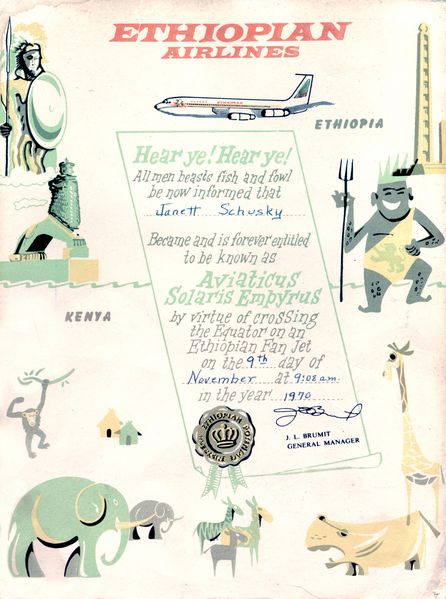 On November 9th, 1970, Janett Schusky was flying on an Ethiopian Airlines 'fanjet' plane (Probably a Boeing 720) when it collided with a natural feature: the Equator. Impacting this line, 90° off the rotational axis of the planet Earth, caused damage to neither passengers nor craft, but Schusky's survival entitled her to the title " Aviaticus Solaris Empyrus", seemingly a jumble of important-sounding Latin words that may translate to something along the lines of " Flyer to the Heaven of the Sun." Ethiopia's famine and troubles during the 80s and 90s may make it seem backward and aboriginal, but they've been operating an airline as long as many European countries. Unlike last week's TWA certificate, which promotes air travel as a worldly benefit, Air Ethiopia's certificate here seems to promote Ethiopia's connection to the rest of the world, despite having to cross the Equator to get there. Labels: 1970, 1970s, certificate, ethiopian airlines
Socialized Power For Our Children
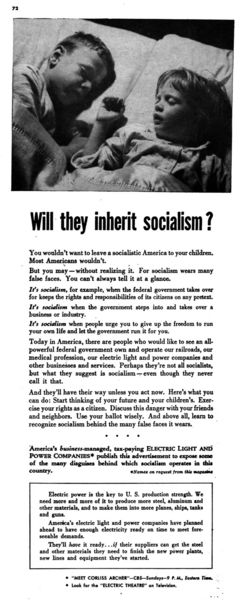 My first reaction was that this advertisement, published in a 1952 farming magazine, was steeped in anti-communist propaganda. After all, socialism and communism are terms arm-in-arm, almost interchangeable, depending on where they're used. The Union of Soviet Socialist Republics was the enemy, we had just defeated Germany's National Socialist party, so in 1952 socialism seemed to be America's greatest enemy. The threat here turns out to be closer to home. Eisenhower, as I mentioned a couple days ago, was quite 'left' when it came to socialized and public works. Socialized power, or, rather, federally-funded power plants, was high on Eisenhower's 'to-do' list. Eisenhower didn't have some haughty Marxist ideals -- he had been a leader during WWII, and saw first-hand how a country's strong infrastructure kept it operating during adversity. Eisenhower's highway system is still the road upon which American commerce and communication rolls, and he thought having federally-controlled electricity would allow the country to weather problems by controlling the source. Private electricity companies, as you might gather, felt quite threatened by the possibility of their racket being leaned on by government influences. "Won't Someone Think of the Children?" the power companies cried, so soon forgetting how Roosevelt's REA program brought hot water and radio to the children of the farmers that bought this magazine. At least with REA, private companies got the money for the work -- turbines at Niagara was another thing altogether.
(click the image to read the content of the ad)Labels: 1950s, 1952, eisenhower, propaganda, socialism
The Northrop Loral F-19-A Specter
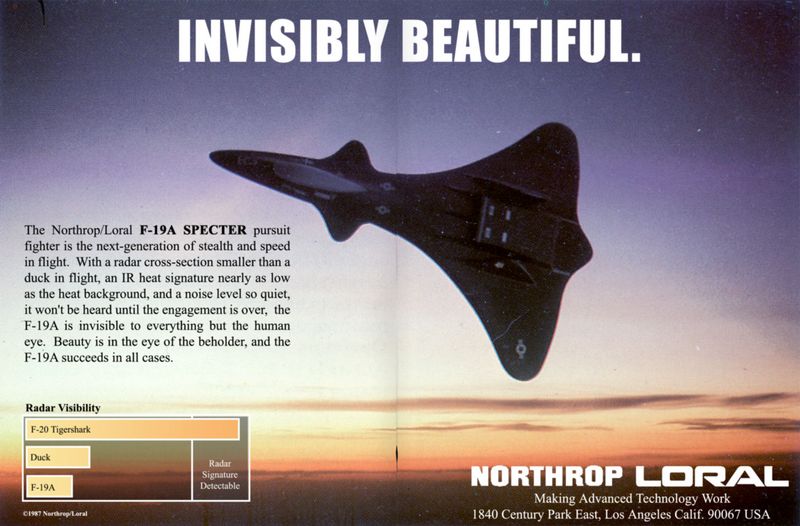 You probably don't know about this aircraft, because its origins and operations are so secret even the US Government doesn't know about it. The F-19A SPECTRE is one of the US' many Stealth fighter aircraft developed in the 1980s. The thing is, these imaginative stealth planes weren't developed by anybody in the aerospace industry. The aircraft design above used for the Monogram's Stealth F-19A Reconnaissance Fighter 1/72 scale model. Whoever designed it was nice enough to include, in various places, diagrams comparable to the usual aircraft graphics seen in Jane's guides, as seen here. This version of the Stealth is my favorite, based on a concept by Loral Aeroelectronics that appeared many places, like the airplane book I scanned the poster's background from, seen above. Testor's version was first on the market and got the most publicity -- including being shown to Congress with the politicians demanding why, if the program was so secret, would a model company be releasing designs to the public? Little did they know, the stealth aircraft in Skunkworks hangers looked nothing like any of the theoretical toy designs. Labels: f-119, f-19, lockheed, nonexistent aircraftN, northrop, specter, stealth
Harriman and the Naughty Strawberry Blonde
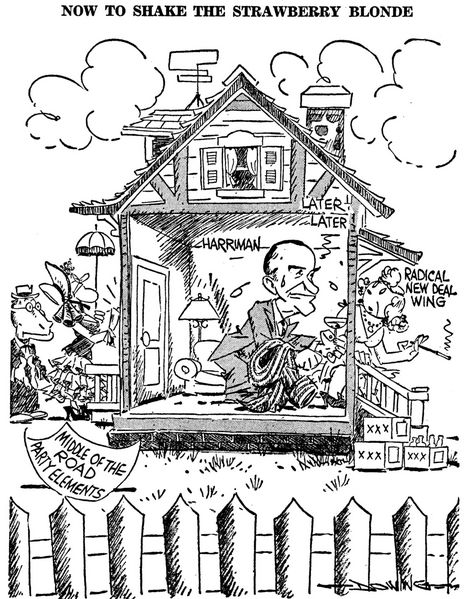 At the end of 1955, candidates were ramping up their target of the Presidency of the US. Adlai Stevenson ended up the Democrat candidate, losing the election, but the second place for the candidacy was Averell Harriman. Harriman was a serious contender; he had been holding offices of one sort or another (the Governor of New York at the time), and a few short weeks after the political cartoon above Harriman appeared on the cover of Time magazine. Harriman was a New Dealer during Roosevelt's days, but his rich family gave him appeal to businesses and the Wall Street crowd. Eisenhower had continued many New Deal programs on his own, so why the comic? Let's take it apart: Harriman, a New Deal proponent, was a early Democrat contender. However, he's got the money and big business interests in his pockets. Eisenhower, too, kept up with the New Deal and worked towards balancing the budget, while working on military strength. Harriman, it seems, was more like the Republican incumbent than the Democrats wanted -- the comic implies that the Democrats were looking for a more centrist candidate. Harriman was 'sleeping' with the leftism of the New Deal, hiding his vices out the back door -- but Harriman was about to greet the centrist Democrats with open arms while his vices patiently waited out back. Public opinion must have agreed -- the more centrist Adlai Stevenson was brought back to run against Eisenhower for a second time, after losing in '52. Harriman, despite his early lead, apparently couldn't shake the strawberry blonde on the back step. Labels: 1950s, 1955, adlai stevenson, political satire, presidential election, w averell harriman
Fargo's North Dakota Skyline
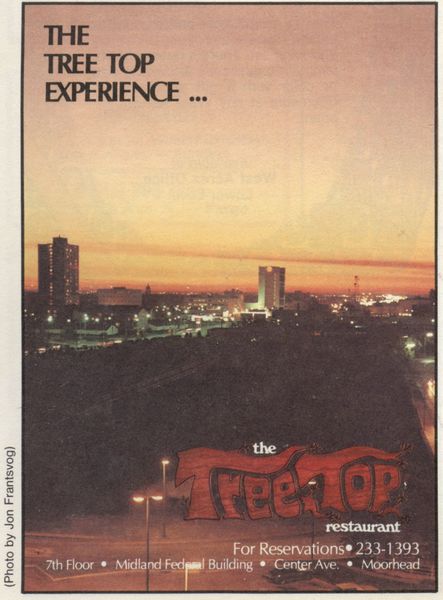 We've seen the North Dakota scenery from West Fargo in the 1930s, which is a little unfair to the area. In 1983, the Tree Top restaurant -- once at the top of the tallest building in Moorhead -- put this photo in their advertisement. At the far left is the low-income highrise, thanks to Urban Renewal; a little to the right of it is the Professional Building, where my childhood doctor worked; a little right of center is now the Bank Of The West building (formerly a half dozen other bank names), and to the right of that is the microwave tower on top of the Burlington Northern offices. We're looking straight west from the MF Building -- but that's not really downtown out that way. Downtown Fargo is off to the right of this photo, and would have been dominated by the Fargo Forum's neon sign, the Black Building, and the First National Bank building. It could be partly that this was the best angle, with the setting sun; it could also be that those were the tallest, most-modern buildings in Fargo at the time, while the next-tallest buildings are examples of Art Deco and Federalist styles of the early 20th century, and who wants to see that? But if they were looking for tall buildings -- why not take a picture of the Radisson? Sorry, that was still two years away. Labels: 1980s, 1983, fargo skyline
Bertha
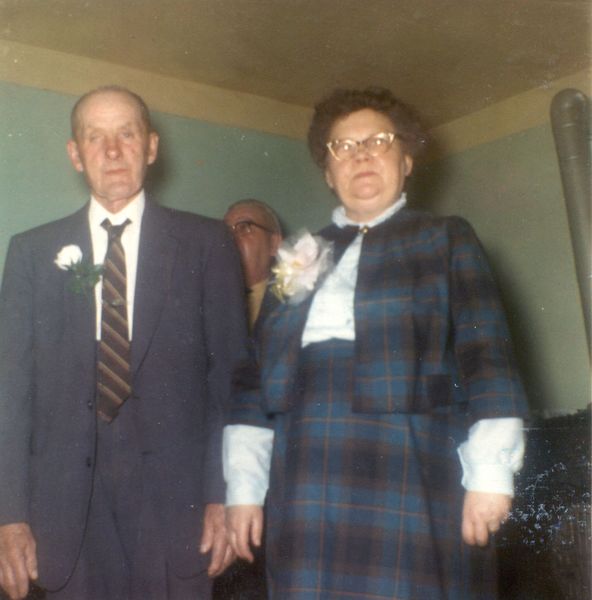 I've started scanning a new family photo album -- another one from Wisconsin, and this one had all the 'good' photos removed, leaving the ones I'm scanning behind. Why were they rejected? I can't tell. Most of these photos are also unmarked -- but the one to the right was important enough to be captioned: " Bertha and Husband." I wonder which one's Bertha? Labels: 1960s, boutinniere, older couple, plaid dress
The Last Binford Guide
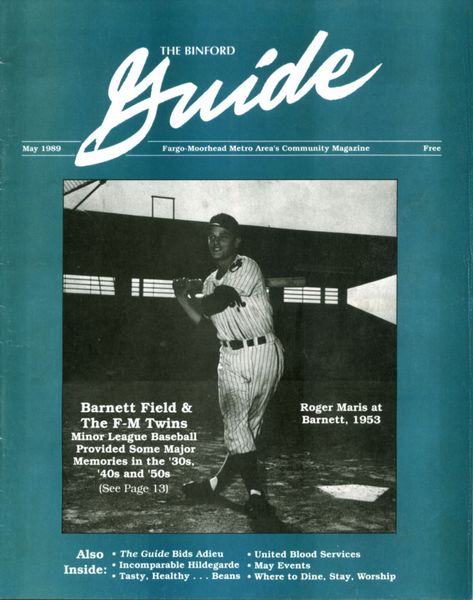 Howard Binford Howard Binford was a journalism icon in the Fargo-Moorhead area during the 60s and 70s, training the media personalities of the future and publishing his own magazine. Late in life, Binford starting publishing his Howard Binford's Guide in 1968, interviewing a series of locals who were quite obviously Binford's friends, church acquaintances, advertisers, and co-chairs on local boards. Still, he was a bright and entertaining editorialist, and the magazine was actually useful to non-locals on holiday and residents alike. Looking forward, Binford began to pass control to his assistants in 1984, sold the magazine to a local publisher in 1986, but his health got the better of him at the end of 1988 and he passed away. Without Binford, the Guide ended publication with the May 1989 issue. The Guide was clearly valuable to the community: most of the magazines I've collected were aquired in large lots -- people saved years and years of the guide in their basement. I've got almost the entire 1980s uploaded, a good part of the 70s, but those 1/8th-size pre-1975 Guides are tough to find. Labels: 1980s, 1989, fargophilia, howard binford's guide
Neptune Rex Endorses TWA
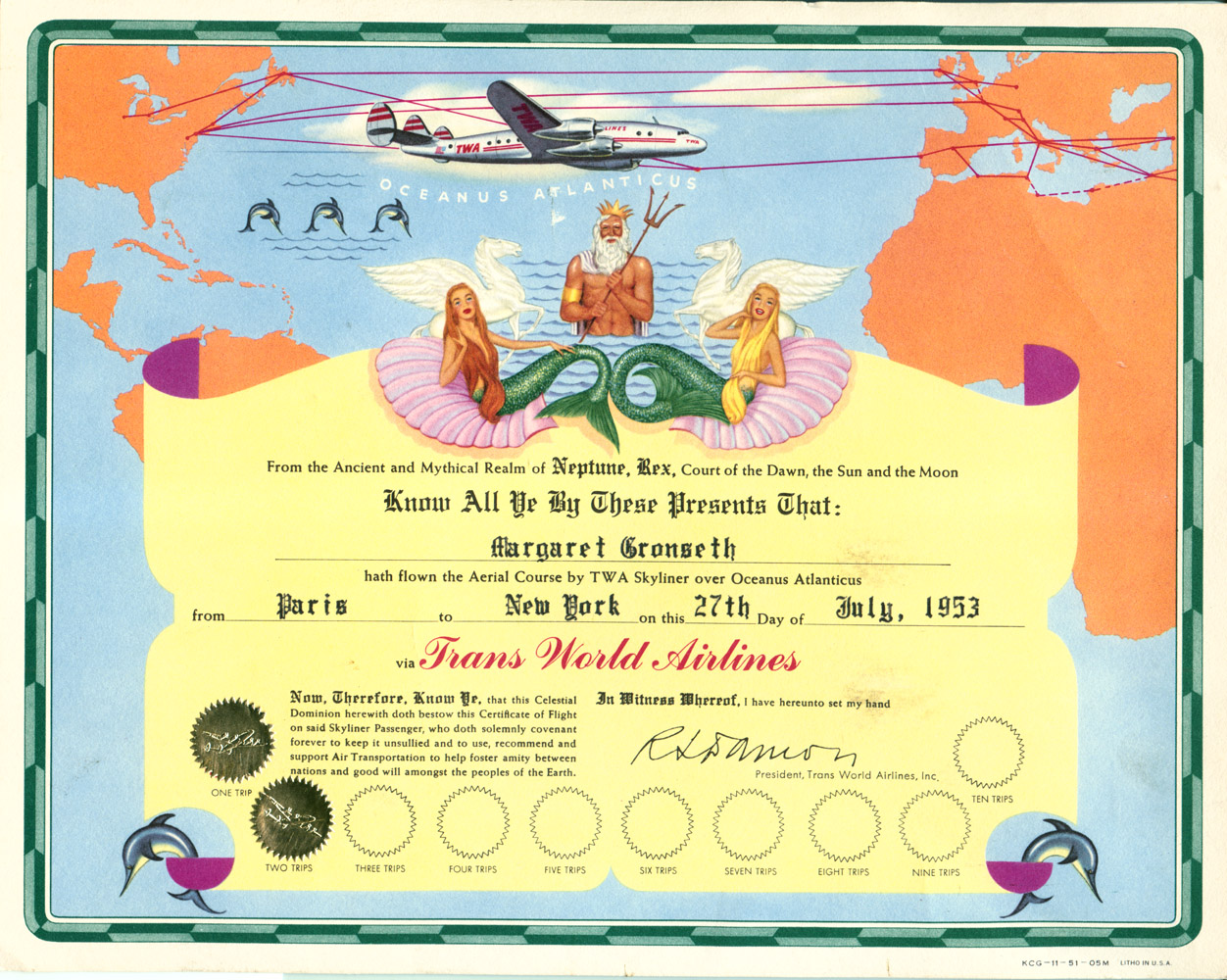 In July 1953, Margaret flew across the Atlantic ocean, from Paris to New York. This was during some of TWAs heydays -- Hughes was in control and hadn't gone completely nuts yet, of travelling abroad was still a luxury but was beginning to reach the common people during the postwar boom, and the process was more comfortable and safer than ever before. The bottom text is the most important to note, though: by being awarded this certificate, the bearer was bound to recognize that they were to promote air travel, and recognize its value to international relations. In the fifties, air travel wasn't just bus service between big cities -- it was diplomacy serviced by stewardesses. see also: TWA history * Lockheed Constellation survivors * Fly TWA museumLabels: 1950s, 1953, certificate, trans world airlines, transoceanic
Angelo's Place - Gulfport Mississippi
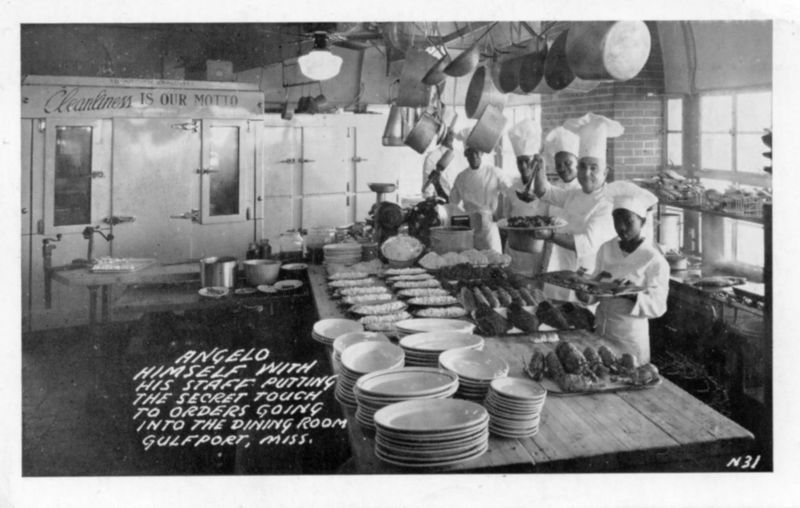 The postcard assumes you know who Angelo is -- this fine chef was so ubiquitous that his first name was enough to tell all who he is. Emeril? Bah -- television was his tool...Angelo was known by word-of-mouth! This postcard is done in the style of real-photo postcards from the 1910s to 1930s, but appears to have been printed much later (and it's not actually a photographic copy). Angelo Xidis immigrated as a teen in 1915, opening his eponymous restaurant in 1935. This would seem to be about the right time for this photo, maybe 1940s. Sadly, Angelo's closed in the 1980s, well after the original Angelo retired, but the restaurant lives on in the numerous postcards that recommended his restaurant to the friends and relatives of a multitude of Mississippi vacationers. Labels: 1940s, angelo's place, gulfport, mississippi, postcard, restaurant
The Hideout at the Comstock
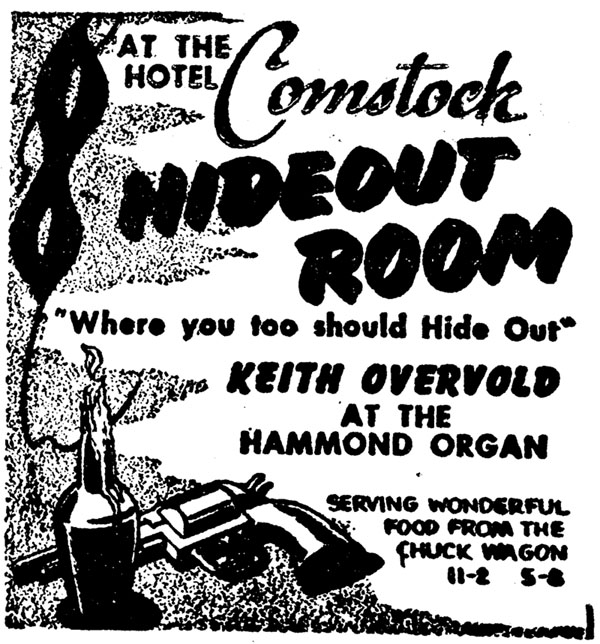 This This came from a 1955 Moorhead Daily News, advertising the Comstock Hotel's Hideout Room. This appears to have been the hotel's lounge, featuring the dulcet tones of the Hammond organ. The Comstock was located in downtown Moorhead until Urban Renewal flattened and re-drew the flood-ravaged section of downtown to build a mall- wrapped- around- city- hall monolithic building that's struggled to keep shoppers and tenants. Personally, I prefer how the Comstock looked to the ultramodern styles of the buildings built in its place. Labels: 1950s, 1955, advertisement, comstock hotel, minnesota history, moorhead
Thumb Problem
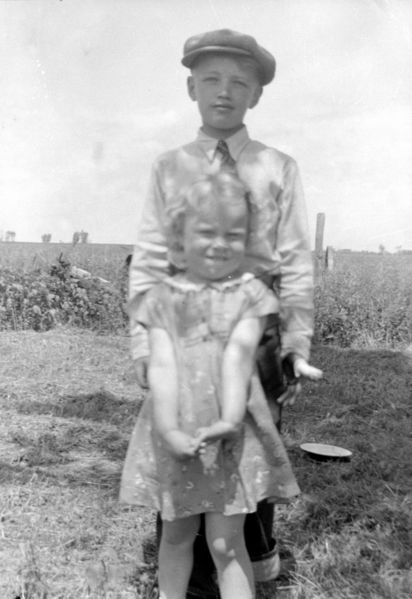 Poor lad -- broken a thumb at such a young age, then made to get all dressed up for family. He does appear to have a brace (the black in his palm), which would indicate a pretty serious break, and the lack of our ultra-modern materials means it looks a lot worse than if you broke it today. These days, we have flesh-colored or transparent high-strength tape and carbon-fiber braces that make it all but invisible. In the thirties, they had cloth tape -- or that might even be a plaster cast. Also, remember this farm was probably a good 5 to 10 miles from the nearest town...if they went to a doctor at all. If a neighbor or even dad was handy with medical supplies, the only doctor consulted was a copy of the Modern Home Medical Advisor that came free with $10 of groceries down at the Red Owl. (from this set)Labels: 1930s, broken thumb, kids, minnesota history
Peek-a-Boo!
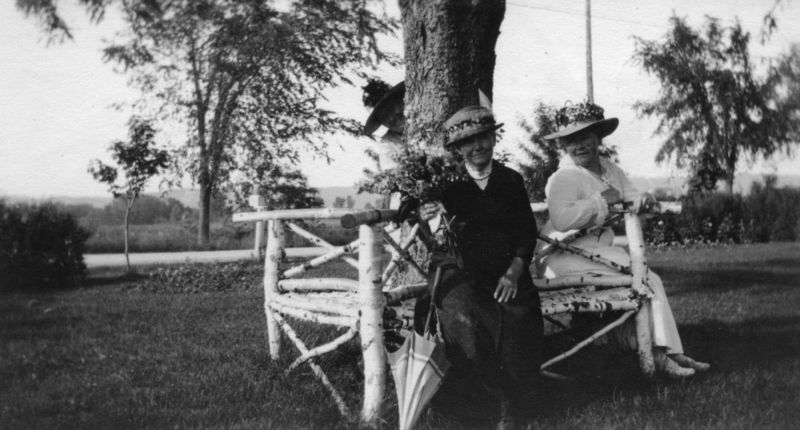 Who's that behind the tree? Why, it's Mrs. Pfeiffer! Helene and her mother visited a nursery for a fine day outside, and that rapscallious Mrs. Pfeiffer brought levity to their day by composing very difficult riddles and singing scandalous bar-room tunes she learned from a set of Victrola records her husband borrowed from the Lodge and hid under his humidor. Or so I gather from two photos taken a hundred years ago -- I may be reading a bit too much into it. I also enjoy this photo for the excellent white-birch bench surrounding the tree. The arm-rests are arranged as an 'x', allowing open seating on all sides. I can't see how it's fastened together, but it seems sturdy enough -- as a bench in a nursery, the raw-woo, bark and all, has a great beauty to partake, when walking through the gardens with your mother and that pernacious Mrs. Pfeiffer. Labels: 1910s, 1917, fashion, gardens, minnesota, nursery
Fish stories on the Upper Sacramento
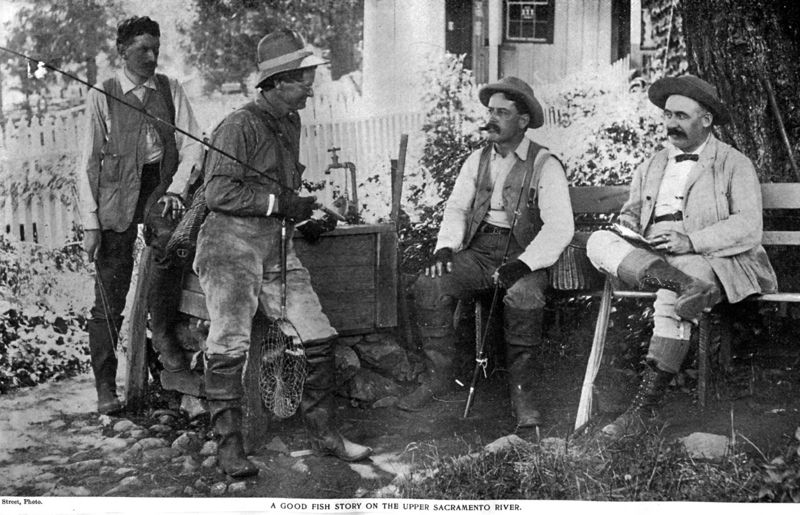 Found in the Pennsylvania Scrapbook, this magazine photo-illustration promises stories, but lacks the text. There's four gentlemen, three that had been fishing, and one hiker (the guy on the far right). The guy in the middle smirks self-assuredly, while the other two fishermen glare -- the smirker is clean shaved and well-dressed, the other two are less well-dressed and decorate their lips with bushy mustaches. A close look discovers that somebody left the water running. It seems there's a funny story or a joke in there somewhere, but without the rest of the story, we don't get it. The one piece of factual information is the reference to the Upper Sacramento River: it's still a fly-fishing haven today, as it was a century ago when the photo was taken, but back in the day the region was equally known for both the beauty of the environment and the logging and mining that took from it. If you were a townie, working in the mines and pulling your dinner from the river, you'd probably be grumpy, too, if some big-city tourist trying to connect with nature outfished you. also: Muriel Foster’s Diary * magical Shasta Springs water * temporary death of the Upper Sacramento
Buckskin Harry, Fargo TV Cowboy
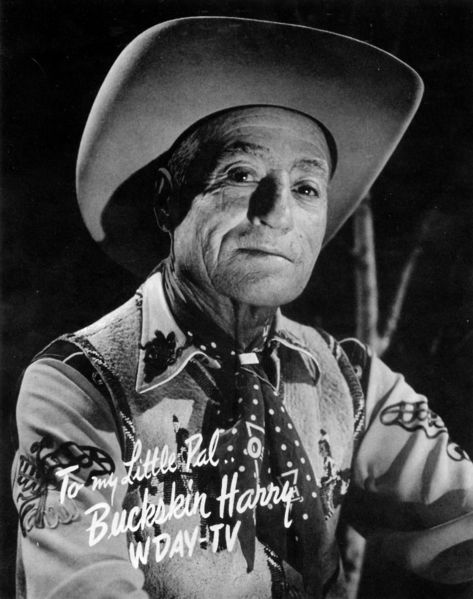 Buckskin Harry Buckskin Harry, as far as I can tell at this time, was a local television personality here in Fargo. Back in the day, local television stations did a lot more local programming than just the news; a lot of the national kids' shows like Bozo the Clown had its roots in local TV stations. Even into the 1980s local stations had thematic characters do intros and commercial bumpers for horror movies. We found this photo in a 1950s magazine, so it gave us a pretty good idea of about when 'ol Buckskin graced the boob-tube. Our first resource was my grandparents -- Grandpa Vernon remembered Harry on TV in the 1950s, but Grandpa was nurturing a new family around that time and wasn't watching mid-afternoon kids' programming. Going through a 1955 Fargo Forum, I found some more specific information: Buckskin was on at 4 in the afternoon, an excellent timeslot lead into by Pinky Lee and Howdy Doody -- and Buckskin's show ran for an hour and fifteen minutes. I'm still doing my digging (my research method consists of doing very little, randomly encountering information...it works pretty well, actually), but if anybody out there remembers Buckskin, I'd appreciate any info. Labels: 1950s, 1955, Buckskin Harry, fargophilia, WDAY
When Flair Was King
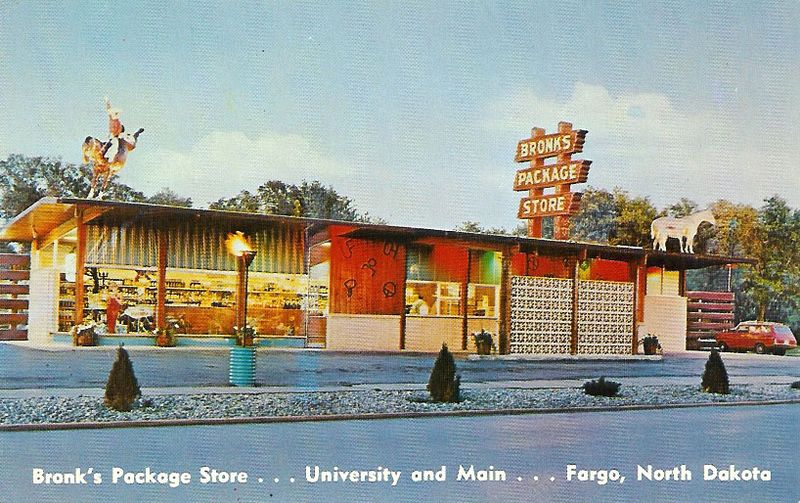 About a month ago, I drove past that ugly modern office building on the corner of Main and University, and struggled to remember what was there before. Then, I found this postcard, and memories rushed back in. No, I don't think I was ever in Bronk's (we were a Polar Package Place family; it was closer to our home), but its central location in Fargo and garish exterior would make it hard to forget. I'm going to look through my archives and see if I can dig up any more on Bronk's, but I don't remember seeing anything about it recently. Today, garish exteriors are reserved for children's restaurants and theme buffets -- the interior of a liquor store isn't inherently anything, let alone to be 'themed' to attract customers. Modern stores aim for neutral efficiency, and 'vice' stores want to project professionalism lest they be called uncouth...but back in the day, when someone said to stop at the liquor store with the cowboy on top, you darn well knew where to go. Bronk's disappeared in the late 80s by my recollection, and was replaced by a law office building. No cowboys on the top of the law offices, sadly. Labels: 1970s, bronk's, fargo, fargophilia, liquor store
Smooching An Old Guy
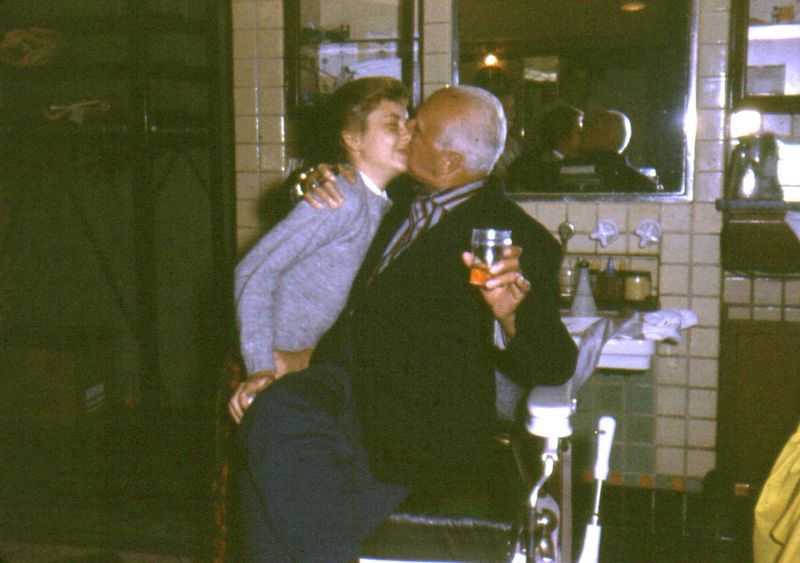 This photo This photo was captioned "Jack, Obie Jordahl's Daughter, 8-24-57". Obie Jordahl, I believe, was a barber at the Pfister Hotel in Milwaukee, and this fine evening he brought his daughter along to a drinking session in the hotel barber shop. Thing got wild -- as you might expect -- and the young miss Jordahl met the fate seen above, photographed and stored for all time. Poor, poor girl. Labels: 1950s, 1957, girl kissing older man, pfister hotel
Howie and his Truck
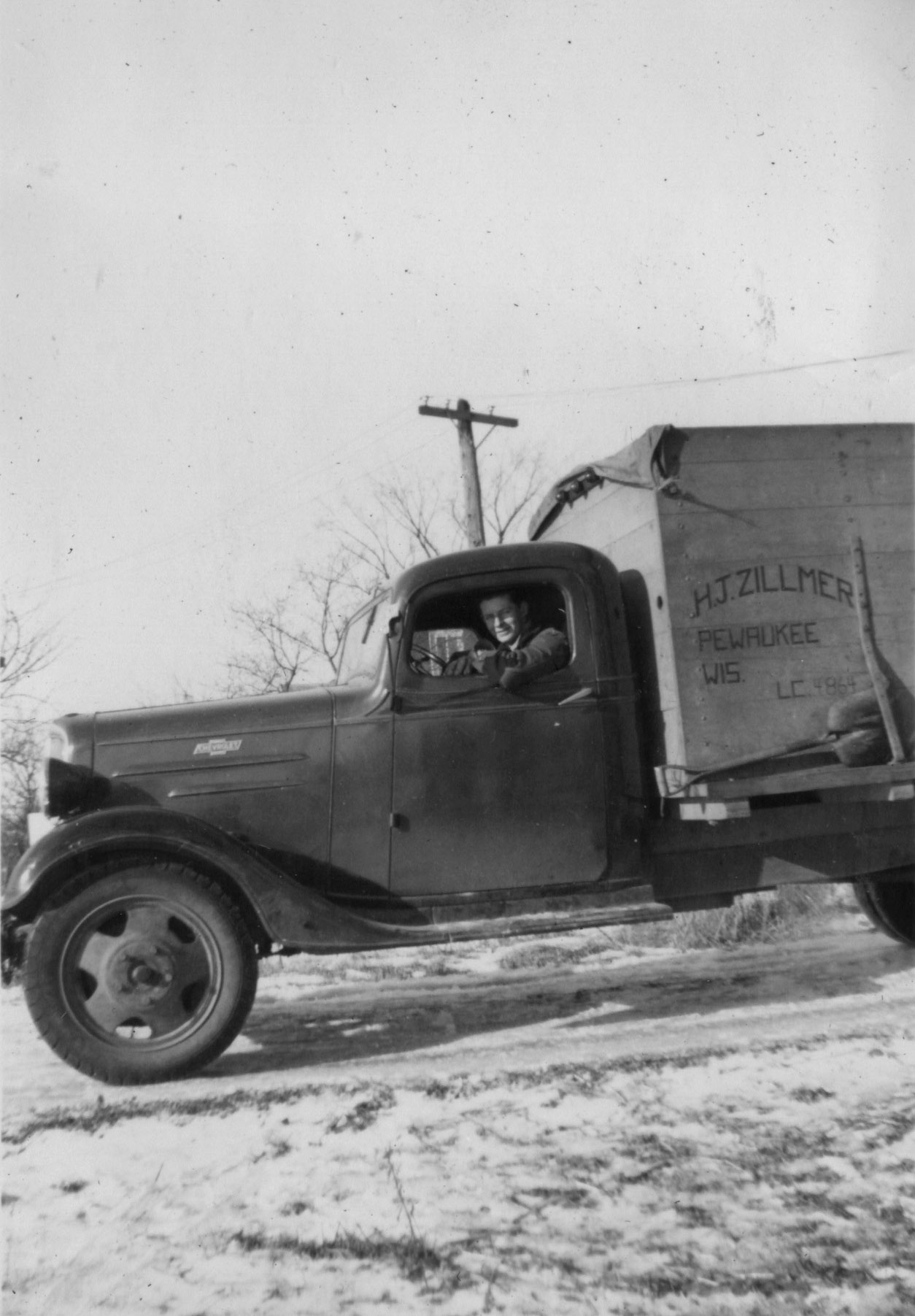 This picture was captioned " Howie." Mr. Zillmer had a truck, was from Pewaukee, Wisconsin, owned a 1930s-era Chevrolet truck, and was friends with the photographer of this album. That's about all we know -- and with this magic of the internet, can anything more be discovered? Not as much as you might think -- Howie could certainly be "Howard Zillmer" -- the internet brings us a flyer from a church in Florida that lists Zillmer's birthday as January third -- Florida's quite a ways away from Wisconsin, though. 2003 brought us the obituary of a Howard Zillmer's mother, Augusta, who had been born in 1910 and lived in Pewaukee. Howard E Zillmer enlisted in the military in Milwaukee shortly after World War II broke out, but -- also in Milwaukee -- Howard R Zillmer held out until '43. Our photogenic Howard, however, looks older than any of the possible Howards on the internet. If internet archives have slowly reached back to the '40s, maybe eventually we'll be able to find Howie. Until then, he's remembered for driving his grain truck past Ruth. Labels: 1930s, 1938, chevrolet, pewaukee, truck grain, wisconsin history
Visions of the Future: Subways!
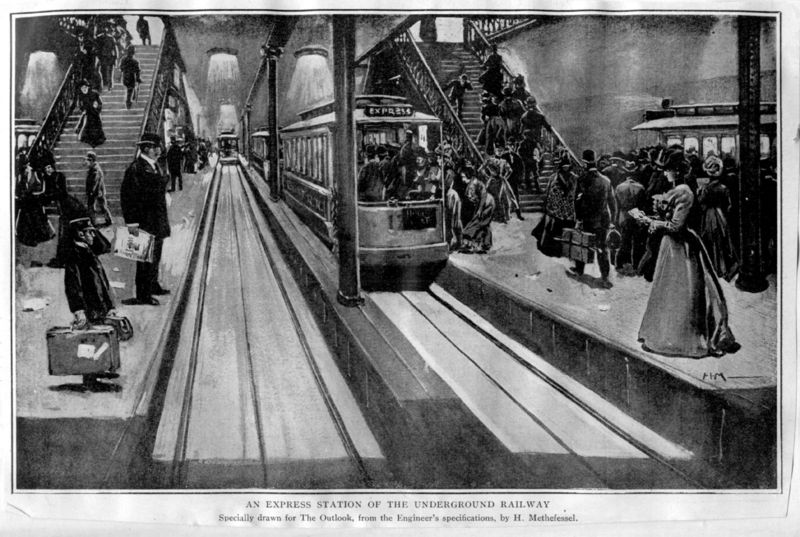 We're accustomed to seeing Artist Depictions Of The Future, mostly in technical magazines showing soldiers with jetpacks, robot soldiers, robots walking dogs, dogs with jetpacks, and so on. This picture, from early 1900s, is an artist depiction of "an express station of the underground railway." This could certainly be a depiction of the Pacific Electric Railway or San Francisco's pre-Muni rail service, given the predominance of California photos in the scrapbook. Really, it could be anywhere: subways were around at the time, so riding trains underground wouldn't have been overly special. Electric underground trains were relatively new, and the addition of "express" is probably a sign of why this deserved attention. The future was here -- where you could board a smoke-less, clean trolley underground, out of the rain, and zip through town to your destination. Only horses and those new noisy automobiles drove the streets...the future was there! Labels: 1900s, futuristic, municipal transit, subway, trolley
Rusk Auto-House Found
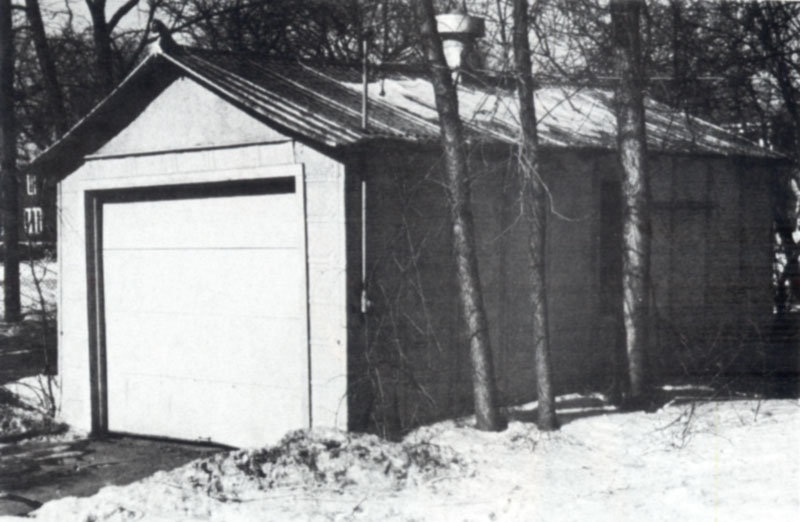 When I first learned about the Rusk Auto-House, I discovered that one was placed on the National Register of Historic Places, Building #87002634 -- but the address didn't make sense. I walked around that block, and found nothing but parking lot. I assumed it was torn down quite some time ago, but in going through my Binford Guide archive I found a photo of that very Rusk. Located on a house's driveway exiting on to 7th avenue, a half block west of Broadway and facing St. Mary's Cathedral, sat this pressed-steel garage. That was in 1988; the garage must have disappeared not long after, as I don't ever remember anything on that corner except parking lot. Labels: 1980s, 1988, fargophilia, national register of historic places, rusk auto-house
The Best Of Friends
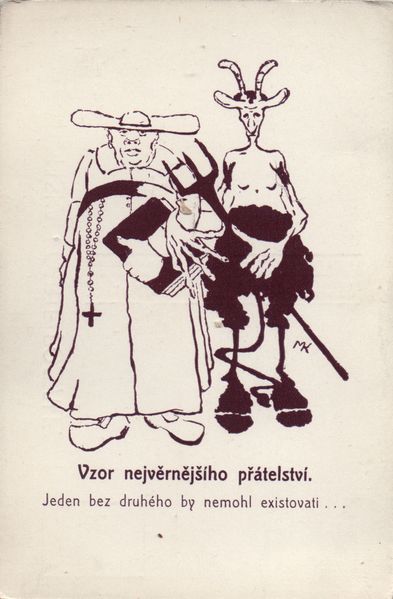 This This is the last of the atheistic Freethought postcards I got at an antique show a few months ago. It's the least witty or thoughtful of the three, but it was the hardest to translate. We've got a priest and a devil, arm in arm, looking a little displeased, but neither is fighting it. The first line reads, "Example of an extreme friendship"; the second says, "A pair who exist due to afflictions." This sentiment is similar to the first card, an attitude that the church preys on people who aren't giving their condition enough thought and trusting in religion. It's an odd thing to be anti-church, while using the church's boogey-man as the reson for the comparison, but, hey, it works. Me, I personally really like the stylized devil he drew -- in today's modern culture, we almost universally show a "Mephistopheles Dracula", a red-skinned suave gentleman with a van-dyke beard, stylish cape, and tiny horns on the forehead. Or, we depict Satan like the Incredible Hulk, with huge teeth and bulging muscles. This Czech devil (probably intentionally) looks ill and weak. A fat, well-fed cleric and an impotent devil? That probably meant more than a weak analogy. Labels: 1900s, 1907, church, czech, devil, postcard
Enid Brant, Scrapbooked
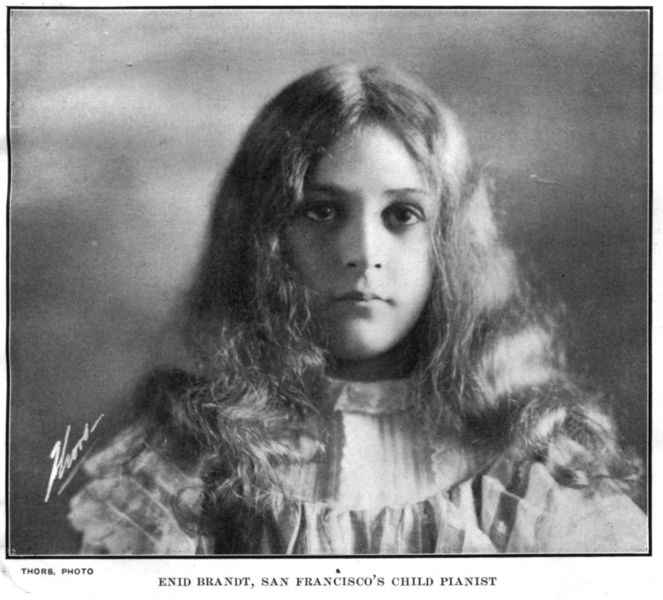 All we have to go on is her caption: Enid Brandt, San Francisco's Child Pianist. Her photo comes from the Pennsylvania Report Scrapbook, what we'd consider 'altered art' today. The book was originally the " Pennsylvania Report of the Superintendent of Public Instruction, 1895," but an industrious photo-lover cut photos out of magazines and glued them over the top of the less-than-interesting education statistics. Most photos appear to be from glossy magazines of the time, and they all seem to range in the 1900-1905 range, based on photos of politicians and other places. One thing missing from the scrapbook, despite the amount of California photos? The San Francisco Earthquake of 1906. Enid doesn't appear in Google as growing into a prodigy and master of her instrument; I hope the talented young lady made it through the quake and fire. Labels: 1900s, enid brandt, pennsylvania report scrapbook, pianist, san francisco, vintage photo
Helene's Swamped Canoe
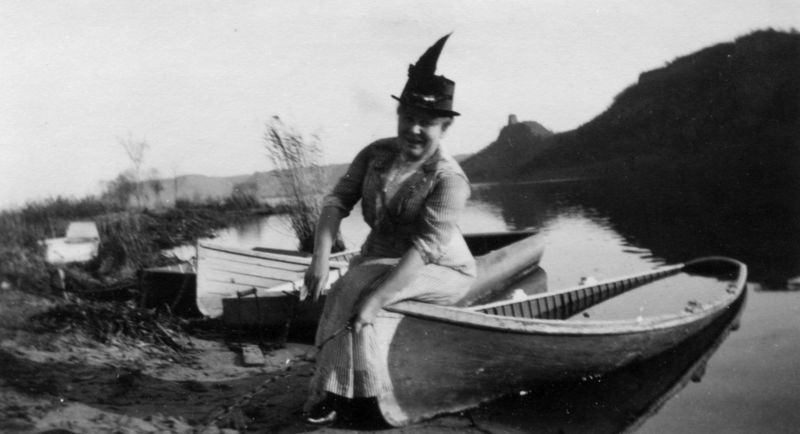 Don't look now, Helene, but your fishing excursion isn't going to get very far. Helene sent a copy of this photo to Marie ( along with several others), probably because Marie was along on this girls-day-out. It's sure good she's near shore, though; unswamping a canoe in a long dress and snazzy hat would be quite difficult. Helene doesn't appear too nonplussed -- she's got a few other canoes behind her to pick from. Labels: 1910s, 1916, canoe, lake, minnesota
Arrangement in Gray and Black: Melby's Mother
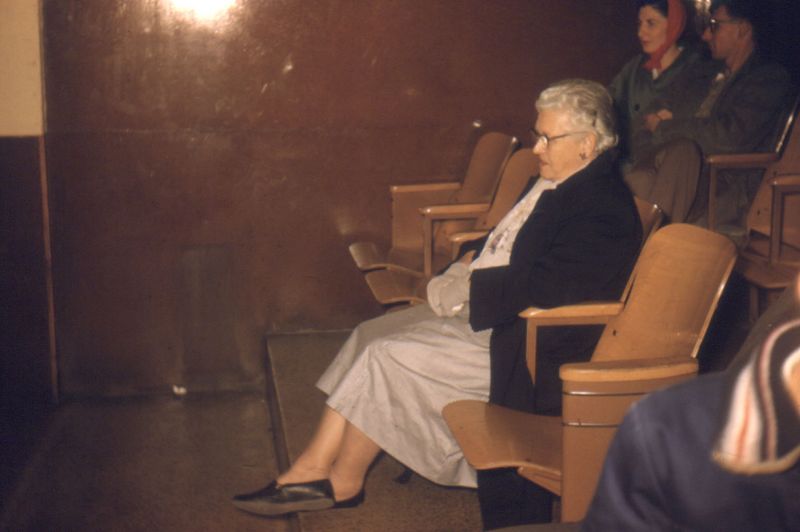 Whistler's Mother Whistler's Mother (otherwise known as Arrangement in Gray and Black No. 1) is an iconic image in our culture, recalling a Victorian silence and respectability. Mrs. Melby's Mother, above, spent Halloween 1960 at a bowling alley. My, how times change is a little less than a century! Not quite as much as you may think, though -- the style of dress is similarly modest, although Mrs. Melby has gone stocking-free and is showing a little ankle. Her chair is similarly spartan, although anyone who attended a high school built earlier than 1960 is probably intimately familiar with such folding seats; many a small finger has been bit by those steel hinges while screwing around during an oh-so-important school assembly in the auditorium. Labels: 1960, 1960s, bowling, minnesota, vintage photo
|  |
|
|
 You may think Wednesday's crack about Grandma getting tipsy off a couple ounces of Miller High-Life was a joke, the photo above shows that the Cool Kids drank High Life. This is clear proof is from the Pfister Hotel set, but the distinctive trapezoid label with an 'X' sticker right above it makes the bottle very recognizable even in small photos from other sources. Granted, these photos are from Wisconsin -- Milwaukee is the home of Miller Brewing, and until the 70s there wasn't as much national distribution as there is today. People tended to drink the beer that was brewed nearby, partly out of sentimental reasons, but also because you knew the beer was fresh. Your parents probably have stories about driving to another state to buy some good beer -- driving from North Dakota to Colorado to buy up a pickup-truckload of Coors has been told to be by more than one person. One poster at Beer Advocate tells of driving to Wisconsin for some High Life...but more because of the lower drinking age of 18. As for the sentimental reasons, High Life had already been around for fifty years by the time this photo was taken -- it was "the champagne of beers", for crying out loud. Regardless if the stuff tasted like crap, you didn't dare buy something else when company was coming over, and being caught at a swanky hotel lounge drinking anything else would be a travesty.
You may think Wednesday's crack about Grandma getting tipsy off a couple ounces of Miller High-Life was a joke, the photo above shows that the Cool Kids drank High Life. This is clear proof is from the Pfister Hotel set, but the distinctive trapezoid label with an 'X' sticker right above it makes the bottle very recognizable even in small photos from other sources. Granted, these photos are from Wisconsin -- Milwaukee is the home of Miller Brewing, and until the 70s there wasn't as much national distribution as there is today. People tended to drink the beer that was brewed nearby, partly out of sentimental reasons, but also because you knew the beer was fresh. Your parents probably have stories about driving to another state to buy some good beer -- driving from North Dakota to Colorado to buy up a pickup-truckload of Coors has been told to be by more than one person. One poster at Beer Advocate tells of driving to Wisconsin for some High Life...but more because of the lower drinking age of 18. As for the sentimental reasons, High Life had already been around for fifty years by the time this photo was taken -- it was "the champagne of beers", for crying out loud. Regardless if the stuff tasted like crap, you didn't dare buy something else when company was coming over, and being caught at a swanky hotel lounge drinking anything else would be a travesty.






























